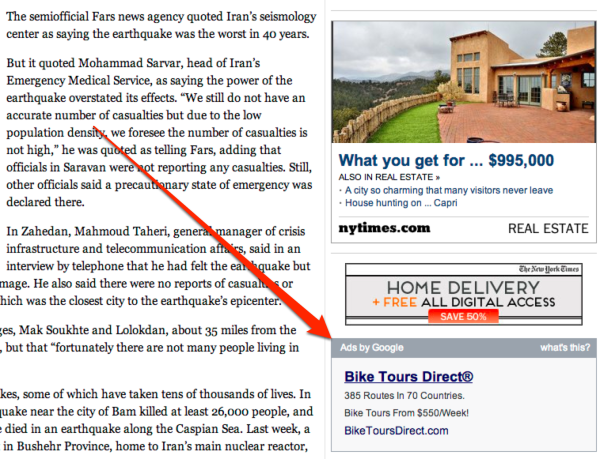The Crazy Way The IAB Defines Internet Ad Revenues
The Internet Advertising Bureau released its latest statistics on Internet advertising spend yesterday, with digital ad revenues now poised to overtake broadcast TV spend. And, look at that growth in mobile! But then again, digging into the stats, the way IAB classifies spend into different categories raises some serious questions. There’s no doubt in my […]
 The Internet Advertising Bureau released its latest statistics on Internet advertising spend yesterday, with digital ad revenues now poised to overtake broadcast TV spend. And, look at that growth in mobile! But then again, digging into the stats, the way IAB classifies spend into different categories raises some serious questions.
The Internet Advertising Bureau released its latest statistics on Internet advertising spend yesterday, with digital ad revenues now poised to overtake broadcast TV spend. And, look at that growth in mobile! But then again, digging into the stats, the way IAB classifies spend into different categories raises some serious questions.
There’s no doubt in my mind that Internet ad spend continues to see phenomenal growth. But, how much is search really growing? Or digital? Or mobile? If you get into the fine print, it becomes clear that answers to this aren’t clear at all.
When A Search Ad Isn’t A Search Ad
For example, consider a display ad that you see on your phone. Is that display spend or mobile spend? According to the IAB, it’s a mobile spend — despite it being a display ad.
The same is true if you see a search ad on mobile. Despite you having done an actual search, resulting in a search ad, the IAB considers that spend to be a mobile spend.
You’ll find all this when you dig into the IAB report (PDF), into the definitions at the end. For “Mobile Advertising,” this is:
Advertising tailored to and delivered through wireless mobile devices such as smartphones (e.g. Blackberry, iPhone, Android, etc.), feature phones (e.g. lower-end mobile phones capable of accessing mobile content), and media tablets (e.g. iPad, Samsung Galaxy Tablet, etc.).
Typically taking the form of static or rich media display ads, text messaging ads, search ads, or audio/video spots, such advertising generally appears within mobile websites (e.g. websites optimized for viewing on mobile devices), mobile apps (e.g. applications for Smartphones running iOS, Android, Windows Mobile or other operating systems), text messaging services (i.e. SMS, MMS) or within mobile search results (i.e., 411 listings, directories, mobile-optimized search engines).
Got it? Search ads, if they appear on a mobile device, suddenly are no longer considered search.
Of course, one of the changes with Google AdWords Enhanced Campaigns is that advertisers lose the ability to target tablets separately from desktops, with true mobile targeting now a “multiplier” based off desktop.
Given this, will those tablet search ads still count as “mobile” in the IAB’s calculations? Will someone running mobile search ads because Google has made it harder to opt-out be considered mobile as well? And if Google is seeing less a distinction between the mobile and desktop, why’s the IAB doing so?
The Importance Of Proper Categorization
Robbing revenue from other categories to create a “mobile” category also poses real issues to the trending data that the IAB is trying to present. For example, is search really not growing as much as the internet advertising category overall? That’s what the report says:
Search totaled $16.9 billion in FY 2012 revenue, compared to $14.8 billion in FY 2011. This 14.5% increase is slightly below the overall industry growth of 15.2%, likely due to a shift to Mobile Search, now captured in the Mobile format.
You have to read close to really understand the cause. It’s not that people actually spent less on search. It’s that search ads on mobile devices now get counted as “mobile spend.”
When A Non-Search Ads Becomes “Search”
Meanwhile, a long-standing issue I’ve had with the IAB figures continues. Contextual ads get counted as search spend, rather than display spend, even though these are more related to display advertising. From the definitions:
Contextual search – payments made for clicks on text links that appear in an article based on the context of the content, instead of a user-submitted keyword. Payment only occurs when the link is clicked.
Read that definition, then look at this:

That’s an article from the New York Times. The arrow points to a contextual box full of ads that come from Google. The IAB considers these ads to be “contextual search,” despite the fact that absolutely no search happened to show me these ads.
The only reason “search” gets involved is because way back when Google first popularized contextual ads through AdSense, the IAB — like Google itself — lumped that type of spend in as “search,” even though no actual search activity happens.
The Need For Better Counting
To recap, we have the latest IAB report that:
- Doesn’t count search on mobile as “search”
- Counts non-search contextual ads as “search”
- Doesn’t count display ads as display if they contain rich media
These issues, among others, are a bad way to be counting figures, especially for an industry that’s about to eclipse the biggest area of ad spend out there, broadcast TV.
Rather than subtract some search spend in order to have a “mobile” category or subtract some display spend to have a “rich media” category, why not show the overall categories of spend: display, search, email and so on. After that, separately show where this spend is happening: desktop, tablet or mobile. And separately again, show subcategories: within display, the rich media or contextual ad spend.
That seems to make more sense.
FYI, I’m on vacation this week (and clearly not doing a good job of it), so I’ll be following up more with the IAB when I get back, to delve deeper into the figures and categories.
Postscript: See also our Mobile Ad Revenues $3.4 Billion, Search The Biggest Contributor post from Greg Sterling, who explains that later this year, categories within mobile (search, display, etc) are likely to be broken out. That’s good, but unless they’re put back into the master categories, those will remain off.
Contributing authors are invited to create content for MarTech and are chosen for their expertise and contribution to the search community. Our contributors work under the oversight of the editorial staff and contributions are checked for quality and relevance to our readers. MarTech is owned by Semrush. Contributor was not asked to make any direct or indirect mentions of Semrush. The opinions they express are their own.
Related stories